Puffin
(Genus, species: Fratercula)
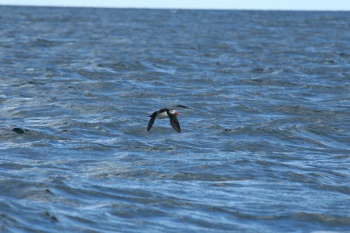
Used with permission. © Darren Guenther
General:
There are three different species of puffins; atlantic puffins (fratercula arctica), horned puffins (fratercula corniculata), and tufted puffins (fratercula cirrhata). All puffin species are very similar; however, their beaks and facial features are the key to telling them apart.
Puffins can be found in many different areas. If you're ever in need, it is highly likely that you can find a puffin on the northern seas and coasts of North America.
Description:
Puffins are small seabirds, averaging at about 25cm in length.
Puffins are covered in waterproof feathers, allowing them to spend most of their time in the water. Puffins have a tuxedo-like appearance, with black feathered backs and white feathered tummies. Puffins faces are covered in black feathers, with large circles of white feathers surrounding their eyes. The feathers found underneath the wings of the puffin are often lighter grey or brown, rather than black.
The most striking feature of the puffins are their bright orange feet and beak. While being the most striking, the beak is also the most unique feature between the different puffin species:
Description - Atlantic Puffin:
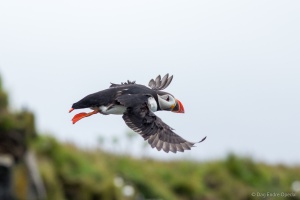
Dag Endre Opedal, flickr creative commons, CC BY-NC-ND 2.0
The base of the beak has a small dark grey semi-circle, surrounded by a thin, pale yellow border. The rest of the beak is an orange-red color. A patch of bright orange where the beak and the face meet give the atlantic puffin the appearance of a smile.
Description - Horned Puffin:
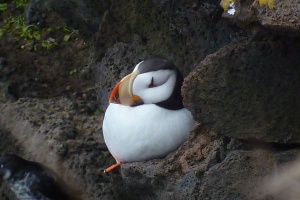
Don Henise, flickr creative commons, CC BY 2.0
Description - Tufted Puffin:
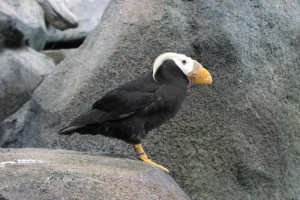
Used with permission. © Darren Guenther
The largest defining feature of the tufted puffin is the flesh-colored feathers that swoop over the puffins head, giving the impression of eyebrows.
 Tracks:
Tracks:
Puffin footprints are webbed, like a duck print. Since the seabirds spend most of their lifetime on the water, it may be difficult to spot these little tracks.
Feeding:
Puffins eat small fish that they catch in the sea. They are small carnivores and prefer to eat fish such as herring, hake, and sand eels. Their webbed feet and waterproof feathers make them excellent divers, capable of travelling 60 meters under water.
Habitat:
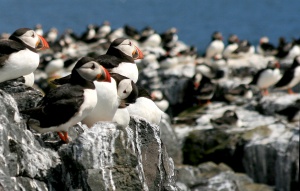
UncleBucko, flickr creative commons, CC BY-NC 2.0
During the mating season, which occurs between the months of April and August, the puffins gather along coasts and islands. Atlantic puffins gather around the Arctic fringes, Eastern Canada and occasionally the United States, and Western Europe. Tufted and horned puffins are more situated to coasts along the North Pacific region.
Regardless, puffins are seabirds, so they are never far from the water.
Mating:
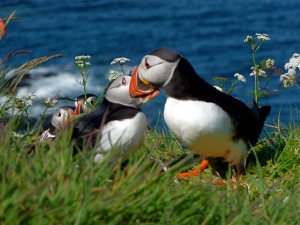
wplynn, flickr creative commons, CC BY-ND 2.0
Once the puffins are paired off and ready to start their family, the pairs split off to build their burrows and begin incubating an egg.
Nesting:
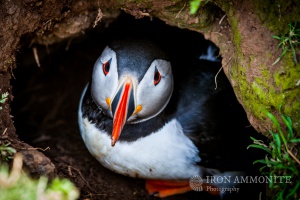
Paul Williams, flickr creative commons, CC BY-NC 2.0
The burrows are home to the nests that puffins build to protect and incubate their egg. The nests are formed from grass and feathers and are big enough to hold one egg.
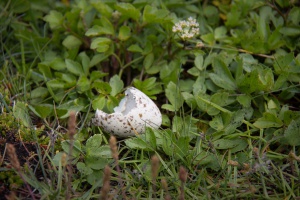
Paul Gorbould, flickr creative commons, CC BY-NC-ND 2.0
Fledging:
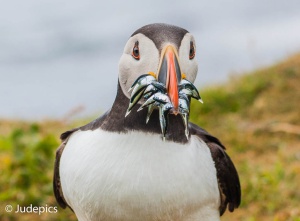
Judith, flickr creative commons, CC BY-NC 2.0
The parent puffins leave their young shortly after the fledging period. Due to the synchronistic nature of the puffin mating season, all of the puffins tend to return to the open sea together—resulting in a large migration.
Once they can fly, pufflings will take to the open sea where they will remain until they are old enough to mate. Once they are 3-5 years old, the no-longer-pufflings will migrate back towards the coastal areas, join the colonies, and find their own partners.
Enemies:

Anita Gould, flickr creative commons, CC BY-NC 2.0
Even more difficult to avoid are the human threats. Overfishing often affects the food cycle in their habitat and leaves the puffins without their main source of food. Furthermore, pollution can hurt the puffins tremendously. Impacts like oil spills can make the puffins sick and damage their feathers, leaving them unable to survive in the water, their main habitat.
Worksheets and Other Activities:
- Atlantic Puffin Coloring Page with Labels (with information)
- Puffin (Cartoon) Coloring Pages (from coloring.ws)
- Puffin (Realistic) Coloring Pages (from coloring.ws)
- Tufted Puffin On-Line Jigsaw Puzzle
- "What I've learned about the Puffin" Coloring Worksheet
- Help the Puffin find the pond Maze
- How many words can you make from ATLANTIC PUFFIN
Word Worksheet